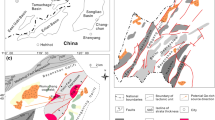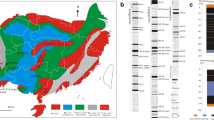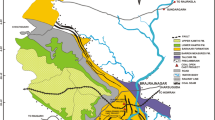Abstract
Mineralogy and geochemistry of No.6 Coal from the Heidaigou Mine of the Jungar Coalfield of North China were studied using instrumental neutron activation analysis, inductively coupled-plasma mass spectroscopy, X-ray fluorescence spectrometry, and scanning electron microscope equipped with an energy-dispersive X-ray spectrometer. The results show that gallium concentration is as high as 44.8 μg·g−1 in the whole coal-channel sample, and varies from 30.1 μg·g−1 to 76.0 μg·g−1 (mean 51.9 μg·g−1) in the main minable benches of No.6 Coal. Such high concentration of Ga in the coal is far higher than the industrial grade (30 μg·g−1). The thickness of the main minable benches accounts for 81.9% of the whole coal bed. The laboratory high-temperature ashes (550°C) of the main minable coal benches also contain a high concentration of Ga, varying from 62.2 μg·g−1 to 178 μg·g−1, with an average of 89.2 μg·g−1. The boehmite significantly enriched in No.6 Coal is the main carrier of the high Ga in the coal. Average concentration of Ga in boehmite is 0.09%. The average content of boehmite is 6.1% in the whole coal and 7.5% in the main minable benches. Boehmite is derived from the bauxite in the weathered crust of the underlying Benxi Formation in the north of the basin during the peat accumulation. The colloidal idrargillite had been shortly transported from the weathered crust to the peat mire, and owing to the compaction of the overlying strata during the peat accumulation and early diagenesis, the idrargillite colloid had begun to be dehydrated, leading to boehmite formation. A preliminary estimation showed that the ensured and prospected reserves of Ga in No.6 Coal are up to 6.3 × 104t and 8.57 × 15t, indicating a superlarge gallium ore deposit. The particular paleogeography of the Jungar Coalfield and the peculiar carrier of Ga in coal suggest that this Ga ore deposit is unique in the world. Rare earth elements are also enriched in coal and laboratory ashes. The weighted average concentration of the total rare earth elements is 255 μg·g−1 and 830.36 μg·g−1 in the main minable benches and their laboratory ashes, respectively. Because Al is the main composition of boehmite, aluminum and rare earth elements in No.6 Coal are also the available and valuable resources.
Similar content being viewed by others
References
Tu G, Gao Z, Hu R, et al. The Geochemistry and Ore-forming Mechanism of the Dispersed Elements (in Chinese). Beijing: Geological Publishing House, 2004, 368–395
Tang X, Huang W. Trace elements in Chinese coals (in Chinese). Beijing: The Commercial Press, 2004. 6–11, 136–141, 293–310
Finkleman R B. Trace and Minor Elements in Coal. In: Engel M H, Macko S A, eds. Organic Geochemistry. New York: Plenum Press, 1993. 595–607
Swaine D J. Trace Elements in Coal. London: Butterworths, 1990. 1–292
Bouška V, Pešek J. Quality parameters of lignite of the North Bohemian Basin in the Czech Republic in comparison with the world average lignite. International Journal of Coal Geology, 1999, 40: 211–235
Spears D A, Zheng Y. Geochemistry and origin of elements in some UK coals. International Journal of Coal Geology, 1999, 38: 161–179
Palmer C A, Tuncalý E, Dennen K O, et al. Characterization of Turkish coals: a nationwide perspective. International Journal of Coal Geology, 2004, 60: 85–115
Liu H, Zhang Y, Wang H, et al. Study on Lithofacies Paleogeography of Coal-bearing Formations from the Jungar Coalfield (in Chinese with English abstract). Beijing: Geological Publishing House, 1991. 1–35
Wang S. Coal Accumulation and Coal Resources Evaluation of the Ordos Basin, China (in Chinese with English abstract). Beijing: China Coal Industry Publishing House, 1996. 254–312
Dai S, Ren D, Li S, et al. Concentrations of minor elements and regional distribution of arsenic in Late Paleozoic coals from North China Platform. Journal of China University of Mining and Technology (in Chinese with English abstract), 2003, 32(2): 111–114.
Valkovic V. Trace Elements in Coal. Boac Raton: CRC Press, 1983. I, 1–210; II, 1–281
Liang S, Ren D, Wang S, et al. Study of Al-hydrates in clay partings within the Permo-Carboniferous coal-bearing strata in North China. Scientia Geologica Sinica (in Chinese with English abstract), 1997, 32(4): 478–485.
Bouška V, Pešek J, Sykorova I. Probable modes of occurrence of chemical elements in coal. Acta Montana, Ser B, Fuel, Carbon, Mineral Process, Praha, 2000, 10(117): 53–90.
Ward C R. Minerals in bituminous coals of the Sydney basin (Australia) and the Illinois basin (USA). International Journal of Coal Geology, 1989, 13: 455–479
Ward C R. Analysis and significance of mineral matter in coal seams. International Journal of Coal Geology, 2002, 50: 135–168
Goodarzi F, Foscolos A E, Cameron A R. Mineral matter and elemental concentrations in selected western Canadian coals. Fuel, 1985, 64: 1599–1605
Harvey R D, Ruch R R. Mineral matter in Illinois and other US coals. In: Vorres K S, ed. Mineral Matter in Coal Ash and Coal. American Chemical Society Symposium Series 301, 1986. 10–40
Palmer C A, Lyons P C. Selected elements and major minerals from bituminous coal as determined by INAA: implications for removing environmentally sensitive elements from coal. International Journal of Coal Geology, 1996, 32: 151–166
Patterson J H, Corcoran J F, Kinealy K M. Chemistry and mineralogy of carbonates in Australian bituminous and sub-bituminous coals. Fuel, 1994, 73: 1735–1745
Hower J C, Williams D A, Eble C F, et al. Brecciated and mineralized coals in Union County, Western Kentucky coal field. International Journal of Coal Geology, 2001, 47: 223–234
Vassilev S V, Yossitora M G, Vassileva C G. Mineralogy and geochemistry of Bobov Dol coals, Bulgaria. International Journal of Coal Geology, 1994, 26: 185–213
Tatsuo K. Relationships between inorganic elements and minerals in coals from the Ashibetsu district, Ishikari coal field, Japan. Fuel Processing Technology, 1998, 56(1–2): 1–19
Tatsuo K, Makoto K. Mineralogical composition of the Ashibetsu coals in the Ishikari coalfield, Japan. Shigen Chishitsu, 1996, 46(1): 13–24
Cheng D, Shen F, Chai D. Genetic attribute and geological significance of Bauxite Ores in Shanxi, China. Journal of Taiyuan University of Technology (in Chinese with English abstract), 2001, 32(6): 576–579
Lin W. Paleomagnetic features of Sino-Korea plate in Late Paleozoic. Geophysical Prospecting & Geochemical Exploration (in Chinese with English abstract), 1984, 5: 297–305
Liu C, Shi Z. Mineralogy of high alumina clay-bauxite deposits in Shanxi and Henan Provinces. Acta Sedimentologica Sinica (in Chinese with English abstract), 1985, 3(2): 18–36
Sun Y Z, Püttmann W, Kalkreuth W, et al. Petrologic and Geochemical Characteristics of Seam 9-3 and Seam 2, Xingtai Coalfield, Northern China. International Journal of Coal Geology, 2002, 49: 251–262
Sun Y Z, Püttmann W, Kucha H. Geochemical characteristics of a veinlet Kupferschiefer profile from the Lubin mine, southwestern Poland. Acta Geologica Sinica, 2001, 75(1): 66–74
Author information
Authors and Affiliations
Corresponding author
About this article
Cite this article
Dai, S., Ren, D. & Li, S. Discovery of the superlarge gallium ore deposit in Jungar, Inner Mongolia, North China. CHINESE SCI BULL 51, 2243–2252 (2006). https://doi.org/10.1007/s11434-006-2113-1
Received:
Accepted:
Issue Date:
DOI: https://doi.org/10.1007/s11434-006-2113-1




